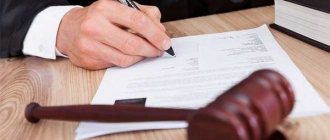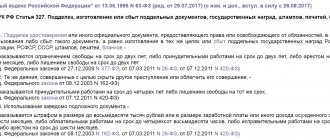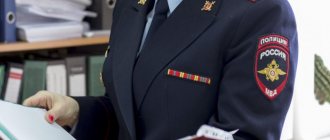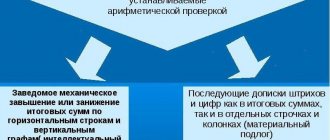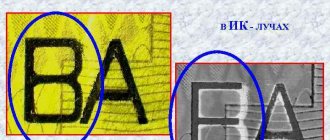On the Internet and in the press there are often offers for the sale of diplomas, certificates and certificates that are obviously fake. Craftsmen carry out their activities illegally, but do not always know that forgery of documents is a criminal offense. Responsibility lies not only with the one who produced the false forms, but also with the one who used them.
The punishment for a person who purchased false documentation and used it will not be as severe as for the manufacturer, but a criminal record will erase any benefits received.
Indicators of criminal activity
The qualifying features of this crime have many nuances.
There are many ways to produce false documents thanks to modern devices and various developments. Therefore, during the trial, it is worth considering each individual case, and a conclusion is also drawn that makes it possible to qualify it under Article 327 or reject this issue altogether. The main options for creating false acts are:
- Various copies are printed on a copier and then used; other copying devices can also be used.
- In the original document, changing an entry by adding it.
- A completed form that was obtained fraudulently or printed on a special device.
- Fraud using a stamp and seal.
- Change in source data.
If the offender performs a mechanical action on a certain document, then an inspection will be carried out to identify changes in these papers. Filling the required information in the authentic forms can be done by adding the required data in it.
For example, changing a real amount with zeros to a larger number by adding different numbers to them. The amount of implausible information entered may be miniscule, but the meaning and content of the document can change dramatically.
Sometimes the fraud is carried out using hand writing; such documents may be in written form. There are certain points that can easily reveal fabricated documents. Almost regularly, criminals try to change original documents using cleaning or some kind of chemical reagents. In this case, such mechanical effects provide an excellent opportunity to preserve the real signature and seal on the form.
Forgery of documents (Article 327 of the Criminal Code of the Russian Federation) is a rather serious punishment, and to determine it, this crime can be qualified in various ways. There are quite a lot of signs in which, after a careful examination, you can see abrasion made with the help of chemical lotions, an eraser or a razor.
After conducting an “experiment” on a document, its adjustment loses its meaning, since the securities and the certificate are distorted, but this makes it possible to gain benefits, as well as cause unique damage to the owners, as well as third parties whose interests are directly tied to the original source.
Forgery of documents (Article 327 of the Criminal Code of the Russian Federation) makes it possible for criminal elements to alter an identity card by changing its various parts. Falsification of a photo on a genuine document is carried out in various ways, but the stamp must be preserved along with the main photograph.
Entire pages can also be changed, for example, it could be a passport, military ID or any other proof of identity. And if the original has many pages, then sometimes scammers can compile them from several outgoing sources.
All kinds of documents can be forged by making copies using various modern technical equipment. Forgery of documents (Article 327 of the Criminal Code of the Russian Federation), namely impressions, is carried out to register false papers, since many of them subsequently have legal status, of course, only after they are sealed with a stamp or seal.
A criminal can easily make any stamp if he has the necessary flare, a print from the original document, or he can do it by copying. Forgery of documents (Article 327 of the Criminal Code of the Russian Federation) is determined by some existing signs, for example, if an image is made, then the main puncture of the compass, grammatical errors and an unclear picture remain.
Types of forged documents
Speaking about the types, it is necessary to consider all the elements of crimes related to forgery and the use of deliberately false papers.
We list the main varieties:
- forgery of election forms;
- official forgery;
- falsification of evidence, etc.
The Criminal Code of the Russian Federation contains more than 20 offenses that include the attribute “use of forged documents.”
Manual signature falsification
The document may be partially legal. But at the same time, it may contain a fake signature of an official. This is most often done manually. To do this, the criminal first obtains samples of the handwriting (personal signature) of the desired official. And then, after some “training,” he puts a fake signature on the document.
By the way, there is a certain category of criminals who specialize in forging documents. The signature they put down is almost no different from the original. Only an examination can establish its non-authenticity. And that's not always the case. Sometimes an expert gives a probabilistic answer to the question posed. The results of such an examination cannot be used as the basis for a verdict.
erasures
There are different methods by which documents are falsified. Erasure is the mechanical removal of parts of text. As a rule, strokes, letters, and numbers are erased with an eraser or scraped out with a knife or blade. When erasing, the top layer of paper is damaged and part of it is removed along with the text elements.
Signs of this procedure are changes in gloss, ruffled fibers, thinning of the paper, blurring of the ink on top of the text, and so on. In some cases, the cleaned area is masked, smoothed, or varnished with something hard. You can also use a solid text outline to hide erasures.
Free legal consultation
We will answer your question in 5 minutes!
Free legal consultation We will answer your question in 5 minutes!
Ask a Question
Ask a Question
Etching
This procedure involves washing off or discoloring with chemical reagents: oxidizing agents, alkalis, acids. Substances affect not only the text being deleted, but also directly on the paper, background grid, and so on. When using chemical etching, changes in the shades of the document will be noticeable.
As a rule, yellow spots appear on the paper. Ink smudges will also be visible when applying text on top, and a weakening of the brightness of the strokes. The latter is a consequence of continued exposure to the chemical reagent remaining in the paper.
Addendum
It represents the addition of individual words, characters, letters, paragraphs to graphic elements. Additional writing is carried out, as a rule, with ink that is the same color as the existing text. The main signs of such a fake are differences in the characteristics of handwriting in the compared parts.
This is also important to know:
Characteristics from the place of residence from neighbors: samples
Letters can have different sizes and thickness. In addition, elements of the same name may have different styles; gaps of different sizes may be found in the document, signs of stops in writing, blurred strokes, offset lines, the presence of a text outline, and so on.
Additional printing
It represents the inclusion of typewritten characters, paragraphs, words, and various symbols. Typically, such changes are made on a small scale. However, they can significantly affect the content.
So, by adding individual numbers and letters, you can change the amounts in invoices, statements, and receipts. The distinctive features of such a counterfeit are discrepancies in the horizontality of the signs, differences in the sizes and designs of the signs of the same name, and the colors of the dyes of the ribbons.
Replacing elements
As a rule, ID cards are counterfeited in this way. In passports, passes and other documents, photographs are most often replaced. Technically, this procedure can be carried out in different ways. For example, a photo can be replaced completely, leaving a fragment with a seal impression, etc.
Re-gluing can be seen by the peeling of the top layer of the form under and around the photograph, the discrepancy in the content, the size of the letters of the text of the print on the photo card and paper, and so on. If you replace sheets of a multi-page document, elements may differ in size, cut line, and color shade. Also visible are discrepancies in the places of punctures and paper clips, in the numbering, number, series of pages.
Forgery of signatures
Falsification in this case is also carried out in different ways. In particular, this can be imitation (imitation) of a genuine sample, copying using technical tools.
Visually, a forgery of a signature can be detected by unobstructed preparatory strokes located next to the stroke, and by signs of slowness in movements (stops, underdrawing, blunt ends of lines).
Forgery of prints
Many documents must be certified with stamps and seals containing certain text and signs. Prints are forged by drawing, making cliches on rubber and other materials, wet copying from the original, and so on. If drawing was used, then in the center of the round seal the mark from the leg of the compass will be visible.
Also noticeable will be the heterogeneity of the pattern and size of the letters of the same name, and their asymmetrical arrangement relative to the dividing elements. Experts often find semantic and grammatical errors in the text of the print. When using clichés, the letters are mirrored and the absence of certain elements is revealed. To avoid this defect, the recopy method is used. For example, first the impression is taken with some sticky material or egg white, and then applied to the form.
Technical forgery of signature
The next option is the technical production of someone else's signature.
This can be a graphic or text program, the results of which are then printed using a printer or other printing device. Also, some criminals make a facsimile of someone else's signature, having previously prepared samples of someone else's signature or a very similar copy of it.
In this case, detecting a fake is even more difficult. Here, additional evidence will be required to confirm that the particular document could not have been obtained legally.
How does falsification differ from official forgery of documents?
Let us analyze how official forgery differs from the use of a forged act.
| Art. 292 | Art. 327 |
| An object | |
| interests of the civil service | normal activities of state authorities and municipalities |
| Item | |
| working documentation | Official acts granting rights or relieving duties |
| Objective side | |
| 1. Entering knowingly false information into a state form. 2. Correction/distortion of previously submitted data | Forgery of official documentation for the purpose of use or sale |
| Subjective side | |
| Self-interest, personal interest | Obtaining any rights, release from obligations, material benefits through sales |
| Subject | |
| Official, municipal or civil servant | A sane individual who has reached the age of 16 |
Who is considered a criminal
Who is considered a criminal?
According to Art. 327, a citizen (or a stateless person) who is at least 16 years old can be held accountable.
If an official is guilty of falsifying documents, then he is not convicted under this article; for officials who falsified documents, there is Art. 201 and 292.
The situation of the criminal worsens if it is proven that he carried out the fraud in order to hide another crime committed or in order to commit a criminal act in the future.
It is worth paying attention to Part 3 of the article, which states that the person who presented false papers will be held accountable. The crime under Part 3 will only be for filing false documents, and it does not matter whether it is an official document or a personal one
Its use is expressed in the provision of false papers to officials in enterprises of various forms of ownership. Responsibility does not arise when using falsified stamps, forms, or seals.
Warning! Criminal liability arises for the use of a forged document with direct intent. That is, a person wants to receive some kind of authority using a forged document or, on the contrary, to relieve himself of responsibilities.
https://www.youtube.com/watch?v=HVjJkOgSNEw
Moreover, it does not matter whether the citizen used the forged document once or systematically. But there will be no crime if a person provides, for example, instead of his ID, a colleague’s document.
Actions involving the use of a document by the creator of a forged document do not qualify under Part 3; his actions are fully covered by Part 1 and in the additional application of the last part of Art. 327 is not necessary.
What does forgery of documents mean?
In the Criminal Code of the Russian Federation, the concept of forgery applies only to state and municipal employees and officials.
Official forgery of documents means the introduction of false information or corrections into them that distort the content. The motive of the attacker is self-interest or other personal interest.
If we are talking about ordinary citizens or organizations, the term “fake” should be used.
Counterfeiting is the production or selection of all components of official paper (letterhead, text, seals, stamps) or the illegal alteration of individual parts of the original.
Forgery is the alteration of official documents by an official.
Which documents are forged?
It is important to distinguish between fictitious documents (forgeries) and forged ones. Fictitious ones are made according to official samples, fake ones are official, but with unreliable data or changes that distort the essence.
Most often, attackers forge passports, driver's licenses, law enforcement IDs, certificates of incapacity for work, sick leave certificates and income certificates.
In case of forgery, deliberately false information is entered into official documents. For example, a doctor specifically writes an incorrect diagnosis into a certificate of incapacity for work so that the “patient” illegally receives benefits.
Forgery of documents is committed only by civil servants.
Forgery of documents, judicial practice
According to statistics, criminals in most cases today falsify the following documents:
Friends!
Our articles are for informational purposes only and will help you solve your problem!
If you still haven’t found a solution, contact a lawyer for advice using the form on the right, or by calling the phone number listed below!
+7 – Moscow, region
+7 – St. Petersburg, LO
+8 ext. 430 – all regions of the Russian Federation
Calls and requests are accepted around the clock, every day. It's fast and free!
- diplomas;
- MTPL insurance policy;
- ;
- health certificates and much more.
We, in turn, wish you to be extremely careful, since, as we said above, in Russia, including in Moscow, there are a lot of scammers operating not only in forging documents and the like. Fraud can ruin destinies!
What is forgery (falsification) of a document?
According to the explanation of the large legal dictionary, falsification is the deliberate substitution of the genuine with the false. If we talk about changing the content of a document, then the mandatory signs of forgery will be:
- committing deliberate actions aimed at making corrections to the content of the document;
- use of obviously incorrect data.
The motive for committing criminal acts will be significant only under certain criminal articles. In most cases, document forgery is for personal gain.
Criminal liability
The penalty for counterfeiting varies depending on the scope of the actions carried out.
It happens:
- full;
- partial;
- selective.
The difference is expressed in the degree of content of unreliable information.
The production of a new document that is false from the moment of its creation indicates a complete forgery. In this case, blank paper is used, which is given the characteristics of an official document, and the corresponding form and content are applied. Signatures and seals are affixed, a series and number are assigned.
Partial forgery consists of adding information to an existing ready-made form that was not originally on it; it consists of reprinting the text, adding numbers and amounts to bank documents, initial pay slips, and forging a signature or autograph. Changes are often made to the purchase and sale agreement, guarantee agreement, and loan agreement. The postscript made significantly changes the meaning of the document, affects its use and value.
Selective document correction is manifested in changing part of the content by changing existing information to new one.
Expressed using:
- Erasures. It is carried out mechanically by erasing, clearing the original text and applying new information on top. It is detected due to the presence of traces of wiping and scratching on the paper.
- Etching. Part of the document is impregnated with a chemical composition, as a result of which the text is blurred. A special feature is the impregnation of paper with a special composition, changing its color and structure. The text information printed on top has a different shade and is slightly blurred, since the paper remains saturated with the composition.
- Replacement of elements. Sheets are replaced (detected by the use of different types of paper, the holes for piercing do not match), photographs (most often the stamp on the form and the photograph do not match).
Their use leads to the recognition of the entire document as counterfeit.
Criminal liability for falsifying documentation under Article 327 of the Criminal Code of the Russian Federation provides for punishment in the form of paying a fine, carrying out compulsory or corrective labor, in the form of criminal liability. There is no provision for decriminalization of the act.
However, bills on criminalization were submitted to the State Duma of the Russian Federation for consideration and received a large number of reviews. For a combination of crimes, a citizen can be detained in order to avoid actions to conceal traces of the crime. The statement of claim is submitted to the court both by the party to the case and by the prosecutor's office.
Jurisdiction of cases under Art. 327 in part 1 refers to the police, that is, the inquiry. Carry out preliminary investigative actions, receive applications from interested parties, and resolve issues within their competence. Jurisdiction of the magistrates' courts at the place of residence of the person.
Article 327 of the Criminal Code of the Russian Federation in its current version regards forgery of a signature as a crime. However, the practice of considering cases in court allows us to conclude that imitation of a manager’s signature does not always lead to punishment. Its placement in reporting documents in order to speed up the further direction of a text that is correct in all respects means that we are not talking about forgery.
How to determine if a document is fake
Suspicions that the document is not genuine can arise from anyone - a boss, a judge, a bailiff, a policeman, a traffic police officer. To determine whether it is a fake or not, you need to know all its signs. Often, the verification is entrusted to experts.
Forensic scientists distinguish three main methods of forgery: complete, partial, and creation of an arbitrary shape.
- Complete fake
Attackers make all the components of a document from scratch - paper, form, details, text, stamps, seals.
Most often, this method is used for papers that are drawn up on blank sheets - certificates, certificates. It is almost impossible to counterfeit complex forms in this way, since various security methods are used: technological, printing, chemical, etc.
- Partial fake
This is making any changes to the original, for example, replacing a photo in a passport. Criminals use various methods - erasing, etching, adding or reprinting, replacing parts, adjusting signatures, forging seals and stamps. Chemical reagents (acids, alkalis, etc.) are also used.
Signs of a forged document
Each method of making a forgery has specific features. It is almost impossible to carry out such actions unnoticed. This is what criminologists use.
- Erasing
After it, you can see a change in the gloss of the top layer of paper, you can notice smeared ink, dye residues, and a decrease in the thickness of the paper.
- Addendum
Signs of additional writing are differences in handwriting or color shades, violation of the symmetry of the text, blurry strokes.
- Changing text
If the text has been corrected, experts notice doubleness, thicker strokes, and extra elements remaining from the previous sign.
- Replacing parts
A deliberately forged document may differ from the original in series and number; most likely, the integrity of the seams holding the pages together, the numbering order, etc. are violated.
If another photo was pasted into the passport, the expert will see it under a microscope, paying attention to discrepancies in the lines of the background grid, traces along the edges of the paste, and a different color of the paper.
Regardless of whether a complete or partial forgery method is used, traces of changes and discrepancies with the original remain.
Qualifying features
Qualifying characteristics
It is important to note that the Criminal Code does not stand for the concept of “forgery of documents.” However, experts have found that falsification can be expressed in the following: . production of counterfeit paper using copying or duplicating equipment; use of forms obtained illegally; use of forged stamps, signatures, seals; corrections made to a document or a completely redone document; changes in part and the full volume of text in a document, which are made by washing, erasing, cutting, etching; adding other records by adding, inserting, pasting.
- production of counterfeit paper using copying or duplicating equipment;
- use of forms obtained illegally;
- use of forged stamps, signatures, seals;
- corrections made to a document or a completely redone document;
- changes in part and the full volume of text in a document, which are made by washing, erasing, cutting, etching;
- adding other records by adding, inserting, pasting.
Document erasure refers to the mechanical removal of parts (or all) of text. Can be done by erasing with an eraser or blade.
Thus, the top layer of paper is damaged, the fibers are ruffled, and the glossy surface is changed.
Etching is changing a document using chemicals (acids, alkalis). This method can help remove text, but it also affects the paper. After etching, yellow spots appear on the paper, the ink may smear, and strokes may become unclear.
Addition (additional printing) is the addition of text in the form of individual words, paragraphs, numbers, and symbols. Such additions are usually made in small quantities, but can significantly affect the content of the document.
For example, amounts in statements and invoices are printed. Such fraud can be distinguished by the mismatch of horizontal characters, difference in ink color, etc.
Objective side
Criminal actions according to Art. 327 of the Criminal Code can be expressed in the forgery of official documents (its production in any volume, in any way). This article also provides for actions only for the sale of documents, forms, seals, awards of the Russian Federation, the USSR, without carrying out fraud with them.
That is, one person was engaged in forging documents, and another citizen presented a false document. Fraud with stamps can consist of creating completely new fake stamps or introducing into stamps that were issued on a legal basis new letters and other details that distort their essence.
Info A crime under this article is already considered completed at the moment when at least one of the actions provided for in one of the parts of Art. 327.
However, there are a number of crimes that are not classified under Art. 327. For example, if a person forged a prescription from a doctor or another document that allows him to obtain a narcotic or psychotropic substance, this is regarded as a completely different crime (Article 233).
https://youtube.com/watch?v=YJ5eXyZP3bo%3Ffeature%3Doembed
In this case, the article on falsification of documents does not even apply additionally.
The danger of such actions lies in the fact that the use of falsified documents (certificates) violates the regulated procedure for the circulation and handling of official papers, seals, stamps, etc.
As a result, the rights of citizens may be violated or, for example, illegal payments may begin to be transferred from the state or local budget.
However, acts of forgery of documents will not be considered a crime under this article if the paper does not provide any rights, benefits and other advantages.
Criminal liability will not arise even if such a document was certified by a notary or other official. Falsification of awards from other states does not fall under this article.
Subjective side
In order for a person to be held accountable for fraud with documents, his act must be expressed with direct intent.
This means that the person is aware of the harm of his action, but despite this, he still wanted to break the law.
The purpose of the crime is to use the manufactured documents (forms, stamps, awards) for one’s own interests or for the benefit of others.
What does the article of the Criminal Code of the Russian Federation say?
In order for a person’s actions to be regarded as a crime falling under Article 327 of the Criminal Code of the Russian Federation, they must meet a number of conditions. First and most importantly, the falsification was carried out in relation to official documents or certificates that are used to obtain benefits or exemption from duties. However, simply producing falsified papers will not entail punishment under Article 327; the offender must use a fake ID or transfer it to another person.
This is also important to know:
Characteristics from the place of residence from neighbors: samples
The issuance of fake seals, stamps, awards and forms is also considered to be forgery of documents. The current Criminal Code does not have a clear definition of the concept of “forgery of documents.” The following actions are considered to be falsification of documents:
- production of fictitious documentation using special equipment;
- use of forms obtained illegally;
- making corrections to an existing document;
- correcting all or part of the text of a document by erasing, cutting, washing out or erasing;
- use of illegally manufactured stamps and seals;
- adding notes and notes to an existing document.
Changes to the text of a receipt, form or certificate can be made mechanically, as well as using printing technology and chemicals. It is important to note that forgery of documents will not be considered a crime and will not fall under Article 327 of the Criminal Code if the documents produced do not provide benefits, rights or other advantages. Also, liability is not provided for persons who falsify awards from other countries.
In order for a citizen to be punished for fraud with official forms, certificates or seals, his actions must have direct intent, that is, the person knows that he is falsifying papers for personal gain. It realizes the possible harm from its action and commits it anyway.
Conditions for avoiding liability
On the World Wide Web you can find a huge offer to purchase fake diplomas and certificates. The “craftsmen” are also involved in issuing fake identity cards. This crime is not only illegal, but also punishable according to the Criminal Code of the Russian Federation. Additionally, it should be noted that the person who knew about this and continued to use them will also be held accountable before the law.
Falsification is subject to punishment in accordance with the Criminal Code.
How to spot a fake
However, for the punishment to take effect, the following conditions must be met:
- A paper that has been supported by a forged signature must be used to obtain benefit in any form.
- The person engaged in forgery must have a specific interest in performing this manipulation.
- It is possible to record obvious damage to third parties.
Based on these rules, we can conclude that not all cases can be punished. That is why a child who forged his parents’ signature in a diary cannot and should not be punished to the fullest extent of the law. Additionally, it should be noted that the certification of documents by a secretary will not be considered in court in the absence of a direct supervisor at the workplace.
What to do if you are accused of forging a signature
Is your teacher accusing you of forging his signature on a record book? A co-worker insists that you forged his signature on a payroll slip? How to prove your innocence of forging a signature on a document?
To do this, you need to order a handwriting examination at the Forensic Examination Center. The examination is carried out as follows:
- the specialist compares the signature of the person whose handwriting was falsified with the signature on the document;
- then he asks the person who owns the signature to write a handwritten text on paper, where he will have to indicate the full last name, first name, patronymic, and also sign.
Based on these studies, the specialist gives his written assessment of the results of the examination.
If it was not you who forged the signature, but it was actually put down by the person whose initials were listed next to the signature, then the results will say that the signature on the document is identical to the one on the passport or on the experimental sheet, which means that the document is not fake.
Proof
Evidence of a violation may be considered in either physical or written form. For example, if there is a false signature on an official document, it itself will be evidence and can be used in court.
If the contract itself or a certain part of it is forged, then the information contained in it will be considered as written evidence.
Expertise
To identify the fact of forgery of an identification mark, a special handwriting examination is carried out. A handwriting specialist carefully checks the signature with the original.
Handwriting examination reveals:
- traces of forgery by copying against light;
- traces of toner on paper;
- characteristic signs of imitation in the form of kinks, uneven lines, edits, underdrawings;
- absence of elements characteristic of the original signature, for example, strokes;
- other features indicating falsification.
Despite the availability of modern methods of creating counterfeits, a specialist will be able to identify the imitation. No matter what level the copy of the signature is, there are still signs by which it can be distinguished from the source.
Changing originals
A document is considered false if the following changes are found in it that distort its true meaning:
- correction of all or part of the information;
- erasing part of the information or completely deleting it;
- introducing additional signs;
- replacing a photograph on an identity document;
- falsification of a signature or seal.
There are many technical, laboratory and visual methods for identifying counterfeit documents. Experts can identify and confirm any changes made to the original.
Methods of counterfeiting
It's no secret that modern technologies are rapidly developing every day. This provides ample opportunity for criminals to create false signatures. In most cases, hand signatures are imitated, since this act does not require specialized equipment.
The most common methods of falsification can be divided into three categories:
| Manual imitation of identification mark |
|
| Manual imitation of an identification mark using available aids |
|
| Falsification using computer programs |
|
By hand
In order to reproduce someone else's signature on paper by hand, you must have a certain talent. Some people have successfully developed these abilities and actively use them, violating the law.
If it is necessary to verify a hand-made signature, an examination is carried out. To carry out the analysis, a trained person obtains the original signature and a paper that is subject to verification. For comparison, as a rule, 10 examples of the original identification mark are taken from its current owner.
However, only documents with manual signatures created not so long ago can be submitted for examination. The thing is that after a certain number of years, a person’s handwriting changes slightly, which makes it more difficult to match.
Technically
Technical methods of falsification include those that use:
- special equipment;
- computer technology;
- improvised means.
The main difference between technical methods and manual reproduction of a signature is that they involve copying the identification mark from the original.
Examples of the most common methods of technical imitation:
- Redrawing the identification mark with a soft pencil and then tracing it with a pen. Such a fake is not difficult to detect due to the fact that pencil marks remain on the paper.
- Use of substances/equipment with copying properties - photographic paper, emulsions, films.
- Printing the identification mark on a laser or inkjet printer. Such a forgery stands out due to the fact that the paper lacks the relief inherent in the signature, and the toner pixels are visible. In addition, if water gets in, such a sign can blur.
- Falsification using an electrographic apparatus. Today it is one of the most popular ways to imitate signatures. A certification sign made in this way is distinguished by the lack of relief and the characteristic shine of the ink.
- Imitation using a facsimile - a printing machine. This type of counterfeit is the most difficult to distinguish, since it has the maximum similarity to the original version. However, such a signature does not have the characteristic grooves that writing instruments leave.
How to prove a forged signature
Imitation is established using handwriting examination. She is appointed by the court.
Such a study is carried out if the forgery of a signature by an official or other person was carried out manually. To do this, the expert is provided with a document with the signature reproduced by the criminal. The victim is also asked to sign. Then the two samples are compared.
If we are talking about technical reproduction, then a technical and forensic study is carried out. Experts pay attention to:
- thickening of strokes;
- paint particles;
- multidirectional movements - mirroring;
- uneven color.
It will not be difficult for a specialist who conducts a handwriting examination to distinguish an original from an imitation.
Expertise
If there is a suspicion that the signature was affixed by another person, the document is sent for examination. The research is carried out by specialists who have all the necessary knowledge and tools for this.
If the signature on a document is too different from the real one, an examination may not be ordered, since the elements of the crime are easily provable.
The method of falsifying the painting is determined first. Falsification can be carried out in two ways:
- Handmade fake. Imitating an autograph “by hand” is the easiest for a handwriting expert. A fake signature differs from the original in the nature of the pressure on the pen, other curls, strokes, etc. With the manual method, the expert often does not need to resort to the help of special tools.
- If auxiliary tools were used when affixing the signature, then such a forgery is called “technical”.
Table 1. Some types of technical falsification of an autograph
Type of technical forgery of a signaturePoints that experts pay attention to
| The signature is redrawn with a simple pencil and then outlined with a pen. | Are there double strokes, how angular are the curls, are there any traces of preparation before redrawing. |
| The stroke is copied using glass, carbon paper, or by pressing. | Are there traces of carbon paper present, and are all the strokes aligned naturally? If there is a suspicion of copying using glass, the expert looks to see if the strokes at the bottom of the signature thicken; in which direction the movements are directed: one or different. |
| They use a computer, laser, scanner. | Presence of printout marks. |
| Ink is transferred from the original document to the fake one. In this case, materials with coloring properties are used, for example, egg whites, photographic paper. | Is there a relief, is the color uniform, are there traces of materials with coloring properties? |
After the examination, the specialist will prepare a conclusion. This document will read:
- What was provided for examination, how the study was conducted.
- What equipment, methods, techniques, tools were used.
- Explanatory drawings may be attached to the conclusion.
- At the end, the handwriting specialist will draw conclusions and write down the results.
Technological progress is moving forward ever faster. Methods for making counterfeits are also being improved, including forging signatures. And sometimes it is quite difficult for experts and law enforcement agencies to identify falsification and bring the culprit to justice.
In especially difficult cases, the court may order the appointment of a commission examination. Its main difference from the usual one is that the research is carried out by at least two professionals from the same field of knowledge.
Comments on Art. 327 Criminal Code of the Russian Federation
The object of the crime is the method of production and sale established by law: papers of an approved sample, stamps and state awards, as well as forms and seals. The subject of the offense is:
- Official or personal documents that allow you to obtain additional rights or avoid obligations of both legal entities and individuals.
- Fake government insignia, gratitude.
In this case, a personal official document is accepted as identification. It contains complete or partial information about the owner. This could be demographic, social, or job-related data. The concept of another official document refers to papers of an approved sample that allow the use of additional benefits or relieve one from any obligations that have been analyzed.
If examined, a counterfeit document will be one that, in the process of certain actions, began to bear the external and qualitative characteristics of the original. Not only the production itself, but also the use for any purpose of a false document will also be considered a crime.
The use of counterfeit papers will be considered to be presented to officials or private individuals to carry out fraudulent activities or to conceal the fact of a crime. The end of the crime in this case will be the moment of production, sale or presentation of false papers or documents containing fictitious information. A person who has reached the age of 16 and has passed a sanity examination will be considered a person who has committed a crime. If it is implied that the person only produced these papers, or is an authorized person, the crime is considered under Articles 327, Part 3 and 292 of the Criminal Code of the Russian Federation. The corpus delicti in this case is characterized by the established fact of an attempt to use false documents.
Statute of limitations under Article 327 of the Criminal Code of the Russian Federation
The expiration of the statute of limitations, after which the attacker cannot be punished by law, is established by Article 78 of the Criminal Code of the Russian Federation. For falsification of documents, the period of 2 years expires, since forgery is not considered a serious or especially serious crime.
Note! If the offense was long-term, the statute of limitations will begin to count from the last benefit received, and not from the date the document was created. Each new offense automatically starts the countdown of the statute of limitations anew.
Responsibility
Article 327, like other articles of the Criminal Code of the Russian Federation, provides for certain liability for violations. The severity of the crime is determined by several factors, so the punishment can be either a fine or imprisonment for a certain period.
Features of bringing to responsibility
To prove guilt, you need to have a document whose falsity has been confirmed by an expert. The paper itself must be in hand, because it is considered material evidence.
However, prosecution has some features:
- The most common signature falsification occurs at work. Emergency situations often occur when papers need to be handed over, but the boss’s signature is not available. There can be no talk of hidden selfish goals here. However, to be sure to avoid punishment, it is worth having written permission from the person whose signature was forged. If there is no such piece of paper, the employee may be fired for exceeding his authority.
- Another situation may be, on the contrary, on the part of the boss. For example, falsifying a signature on a salary slip will allow you to avoid paying wages to an employee. If such a forgery is discovered, you must immediately go to court.
- Forgery of signatures in sales contracts is also common. A falsified document loses its validity, and the attacker will be held accountable.
- Recently, the minutes of the general meeting are also considered official, so falsifying a signature on it is considered an offense. However, judicial practice shows that finding the culprit is usually not easy.
- Routine falsification of signatures on documents is also considered illegal. The punishment depends on the severity of the crime, which is determined by the court.
- False acceptance certificates can result in the contractor not receiving money for his work. This could be a simple mistake or a deliberate forgery. In any case, examination and trial are necessary.
- For violators, falsifying a signature in court can be a more serious crime. In this case, the culprit also violates Article 303 of the Criminal Code of the Russian Federation.
If any falsification is discovered, you should immediately go to court. The trial will determine whether the person is guilty or not.
When there is no responsibility
Often there is no liability for counterfeiting. However, this requires that the fake document be unofficial and not carry any legal force. In addition, it should not relieve one from duties or, conversely, provide preferential benefits. Otherwise, counterfeiting will be considered a violation.
Damage
According to Part 3 of Article 327, in order to initiate a case of forgery of a document, damage must have been caused. That is, if a person forged a signature on a document, but did not use a forgery, thereby not causing damage to a third party, then he will not be convicted under the article. That is why a student who forges the teacher’s signature in a diary will not be punished. But a person who forged an autograph of a famous football player will be punished only if he wants to sell an item that has a fake celebrity signature on it.
Limitation periods
The offense also has an expiration date, after which it will be impossible to open a case against the person. Parts 1 and 3 have a statute of limitations of up to two years, and part 3 has a statute of limitations of up to six months.
Amnesty
Those convicted of falsifying documents may receive an amnesty.
However, only:
- veterans of the Great Patriotic War;
- combat veterans;
- people awarded state awards;
- people exposed to radiation due to the disaster at the Mayak production facility at the Chernobyl nuclear power plant;
- pregnant women;
- children under 14 years of age;
- men and women of retirement age;
- disabled people of groups I and II.
In addition, women and minors are released from further imprisonment if they have served more than one year in a correctional colony.
Ways to bring to justice
In the event that the fact of forgery of documents has become known and it is necessary to bring the culprit to criminal responsibility, you should contact the judicial authorities or the police.
If the identity of the offender is unknown, the application is submitted to law enforcement agencies, where they will take appropriate measures and, consequently, search activities.
Criminal proceedings will be opened for violation of the law. During the trial, a forensic examination may be ordered to determine whether false documents were produced.
Fact
Experts in such matters use tests to check the authenticity of papers.
Based on the results of the work carried out, a written conclusion will be drawn up. An expert may be called to participate in a court hearing to explain the conclusion of the conclusion.
Composition and qualification of the crime
The legislation does not specifically address such a concept as imitation of a signature. It considers only the act that was committed in conjunction with this unlawful act.
The punishment depends on the severity of the crime related to falsification. Some will receive a simple fine, while others will have to serve their sentence in prison.
The subject of the crime in this case is any offender over 16 years of age. Imitation of a signature can be considered from the point of view of making changes to official documents.
The objective side of the crime is the sale or use of paper with a forged signature. There is direct intent in this, since it is impossible to accidentally forge another person’s signature on a document and then use it for a specific purpose.
The illegal act is considered completed at the time the paper is certified with a counterfeit identification mark.
If the guardians of the law discover any benefits when simulating a signature and find evidence of this, then the violator, in addition to Art. 327. of the Criminal Code of the Russian Federation, you will also have to answer under Article 159, which provides for punishment for fraud.
Exceptions
The law does not prosecute the falsification of awards from other states other than the Russian Federation, the USSR or the RSFSR, or the use of original documents of other citizens if no changes have been made to them.
For example, entering a closed area with a colleague’s pass is not a crime - the pass is original and there are no illegal corrections in it. The main criterion of liability is expressed in the punishment for falsifying documents, which directly depends on the purpose for which they were made. The most serious and aggravating crime is falsification for the purpose of concealing another crime or in preparation for its commission. In this case, the manufacturer will be punished for a combination of crimes.
In other situations, the articles do not complement each other - the preventive measure is determined according to the most appropriate of them. A criminal record will have a more negative impact on a person’s future than any benefits received on the basis of false certificates, diplomas and certificates.
Punishment for forgery, production and sale of counterfeit documents, as well as forgery of signatures
The main article for forgery, production of false documents is 327 of the Criminal Code of the Russian Federation.
Let's consider what penalties are provided for various types of counterfeits under this article:
| Perfect crime | Punishment | Name of the law, article |
| Forgery of a certificate or other official document granting rights or exempting from obligations for the purpose of its use or sale of such a document, as well as production for the same purposes or sale of counterfeit state awards of the Russian Federation, RSFSR, USSR, stamps, seals, forms. | Punishment is provided in the form of:
| Part 1 of Article 327 of the Criminal Code of the Russian Federation. |
| If the above act was committed to conceal another crime or facilitate its commission. | The citizen will be punished as follows:
| Part 2 of Article 327 of the Criminal Code of the Russian Federation. |
| Using a deliberately false document. | The citizen is punished:
| Part 3 of Article 327 of the Criminal Code of the Russian Federation. |
There are also several other articles related to falsification of documentation:
- Article 327.1 of the Criminal Code of the Russian Federation. It is associated with the forgery of excise signs and documentation confirming compliance,
- Article 327.2 of the Criminal Code of the Russian Federation. It concerns the falsification of documents that give the right to receive or use medicines or other medical products.
Let's consider what punishment awaits the attacker under these articles:
| Perfect crime | Punishment | Name of the law, article |
| Creation of counterfeit excise stamps, special stamps or marks of conformity, which have protection against counterfeiting, for the purpose of marketing or selling such documents. | The citizen will:
| Part 1 of Article 327.1 of the Criminal Code of the Russian Federation. |
| Use of deliberately counterfeit excise stamps, special stamps or marks of conformity protected from counterfeiting. | For use, a citizen faces:
| Part 2 of Article 327.1 of the Criminal Code of the Russian Federation. |
| Creation for marketing purposes or sale of counterfeit excise stamps, or federal special stamps for marking alcoholic products, or counterfeit special (excise) stamps for marking tobacco products. | The following punishment is provided:
| Part 3 of Article 327.1 of the Criminal Code of the Russian Federation. |
| Using obviously counterfeit excise stamps or federal special stamps for labeling alcoholic beverages. Or the use of deliberately counterfeit special (excise) stamps for labeling tobacco products. | The citizen expects:
| Part 4 of Article 327.1 of the Criminal Code of the Russian Federation. |
| Creation or use of deliberately false documents intended for obtaining medicines or medical products - for example, such as: - Registration certificate. - Certificate. – Declaration of conformity. – Instructions for use of the medicinal product. – Regulatory, technical and operational documentation of the manufacturer (manufacturer) of the medical device. | The attacker will have to:
| Part 1 of Article 327.2 of the Criminal Code of the Russian Federation. |
| Creation and use of deliberately counterfeit primary packaging or secondary (consumer) packaging of a medicinal product. | The citizen will:
| Part 2 of Article 327.2 of the Criminal Code of the Russian Federation. |
| The crimes indicated in parts 1 and 2 were committed by an organized group. | The perpetrators will be imprisoned for 5-10 years and prohibited from engaging in certain activities and holding certain positions for 3 years. | Part 3 of Article 327.2 of the Criminal Code of the Russian Federation. |
We recommend checking the data, as the Criminal Code may be changed.
The information in this article was based on the current code, as amended on March 7, 2022. Still have questions? Just call us:
St. Petersburg 8 (812) 627-14-02; Moscow
Basic provisions
Citizens in everyday life very often encounter the fact of forgery of documents, often without realizing it.
For example, if they sign work forms for another person. But not every such offense will be considered a crime. In order for law enforcement agencies to qualify an act in this way, it must meet certain parameters:
- Forgery is carried out in relation to certificates and other official documents.
- Counterfeiting is carried out out of malicious intent or selfish motives. Those. counterfeit documents must confer illegal rights or relieve duties. Also, their production may be caused by the desire to hide traces of another offense.
Russian laws do not contain a definition of the concept of “official document”. In this matter, it is necessary to refer to the Determination of the Constitutional Court No. 575-0-0 (dated 05/19/2009). It states that formality is determined not by the form of the document, but by its content.
Those. The document must contain legally significant facts that are directly related to the case under consideration. Plus, it is characterized by the presence of two more signs:
- The document is issued by an official authority and is included in the official document flow.
- The document delegates the authority to provide rights or obligations for the owner or third parties.
Criminal punishment will occur only if the act is caused by malicious intent. The social danger of the crime lies in its violation of the procedure for circulation of official documents.
In addition to official documents, the following are considered as the subject of a crime:
- State awards issued in the USSR, RSFSR and the Russian Federation. This does not apply to foreign awards.
- Document forms with stamps.
- Seals and stamps.
Documents can be on any media:
- Printed paper or handwritten version.
- Audio and video recordings.
- Electronic media.
It is possible to speak about the existence of a crime only if the guilty person produces and/or sells documents, the content of which grants rights or relieves them of obligations. If they are created by individuals without notarization, there is no corpus delicti.
The objective side of the crime is the production of false documents. The number of fakes created and manufacturing methods do not matter. Sometimes document falsification is part of another crime. And it does not always require additional qualifications.
For example, in the case of the production of a false medical prescription granting the right to receive drugs containing narcotic substances. In such a situation, the offense is qualified under Art. 233 of the Criminal Code of the Russian Federation.
A crime is considered committed from the moment of completion of any act constituting its objective side. Those. It does not matter whether a person has obtained any rights with the help of a document. If it manufactured or sold it, the crime is considered committed.
The subject of a crime is any individual who has reached the age of 16 and is recognized as legally competent.
Who has the right to bring charges?
The subject of a crime can be any individual or citizen over the age of 16 years.
If the crime was committed by an official or performing certain managerial functions in a commercial organization, their actions are classified under Articles of the Criminal Code No. 292 (Forgery of Officials) or 201 (Abuse of Power).
Also, charges may be brought against an accomplice or a person who used a counterfeit, although he knew that he was using a counterfeit. But the punishment itself will be less severe.
Good to know: legal entities cannot be charged only with forgery of documents, since such a crime is classified under other articles, usually as fraud.


